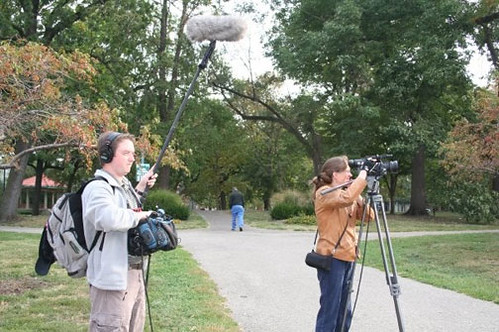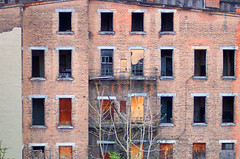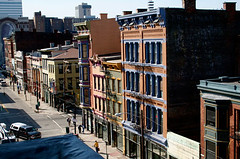Will these talented partners make the definitive revitalization movie?

Posted May 13, 2010 at 1:30PM
Last week I had the pleasure of attending a Washington, DC benefit party for the documentary-in-progress, The Rebirth of Over-the-Rhine. The film is about the restoration of the historic Cincinnati neighborhood of the same name, and the event was hosted by the film’s co-producer Joe Brinker, whom I’ve gotten to know a bit over the last year. Joe asked me to say a few words about the neighborhood’s potential, which is immense, and I was honored to be able to do so.
Over-the-Rhine was named by the German immigrants who settled it a century and a half ago. Like other inner-city neighborhoods, it suffered serious disinvestment and decline over the past several decades, and acquired a terrible reputation for drugs and crime as a result. But, as I wrote here last year, the neighborhood is replete with assets to build upon. Its walkability, historic character (the largest collection of 19th-century Italianate architecture in America), near-perfect location next to Cincinnati’s downtown, and opportunity to apply green technology combine to give it the potential to become one of the best-performing neighborhoods in the country from an environmental standpoint. In addition, while the community's abundance of vacant properties is hardly an asset, it should mean that the restoration can occur without displacing current residents.
It was fun to meet Joe’s very talented partners in the effort, co-producer Steve Dorst and director Melissa Godoy. I also got to hear a pretty good DC band, Suspicious Package, drink some wine, and eat a couple of Cincinnati hot dogs. But the best part of the evening was listening to Joe, Melissa and Steve talk about the film, and seeing a 14-minute clip of their work. This movie has a chance to be very good, and to tell a story that, although unique to Cincinnati’s character and history, is also representative of the comebacks of similarly situated districts in cities across the country (Saint Louis, Indianapolis, Atlanta, Denver and Boston, for example).
I won’t repeat all the things I wrote about the neighborhood last year, but I will quote a passage from the movie's website, written by Joe and quite clearly speaking from the heart:
“In Over-the-Rhine, my roots go back a century. Henry Schmidt, my great-great uncle, like so many other German immigrants, started my family’s Cincinnati story there in the late 1800s (and was soon joined by my grandfather and great uncle). He became a successful masonry contractor, with enough money to build his own house in what is now Norwood. He and his wife were childless, so they sent word back to the village of Klosterholte, Germany for their niece—my grandmother, Elizabeth Schmidt—to come care for them in their old age. Elizabeth married and had three children—one of whom is my father.
“As I grew up in Cincinnati, my first memories of Over-the-Rhine were in the 1970s. I remember the beauty and the decay, the boarded-up facades and the rich smells of Findlay Market. For me, the neighborhood embodied the most authentic strains of Cincinnati culture, from old-world traditions and architecture to African-American sounds and tastes. As I grew older, walking through Over-the-Rhine increasingly left me with feelings of melancholy and loss.
It was a bittersweet feeling – one of the most remarkable and unique places in my city, a neighborhood that truly makes Cincinnati both historic and contemporary, was avoided by most and forgotten by many . . .
“But have you walked Over-the-Rhine’s streets lately? There’s a buzz, an energy: improved safety and security, renovated Italianate facades, new construction, new people, and new businesses. There is a widespread optimism and intent that I have never sensed before.
“Yet change often brings challenges and fear. Long-time residents of the neighborhood worry that they do not fit into plans for a new Over-the-Rhine. And the efforts of others who have committed decades to helping the neighborhood wonder if their contributions and experiences will be taken into account . . . Each of these groups has its own distinct vision of the future, yet all want to see a better Over-the-Rhine. Can they work together to achieve a common success?”
The clip that we saw focused on only a small part of this very rich story, but the three partners have over 200 hours of material awaiting editing, and they are still shooting. This is a big undertaking and, while perhaps a labor of love in many respects, a labor nonetheless. Joe and Steve have demanding and impressive day jobs and Melissa, whose portfolo is also impressive, doesn’t have unlimited time or resources to donate to the project, either. There is no big studio backing them. Thus the fundraiser last week, and more to come, I’m sure (one can also donate through the film's web site).
But what a worthy cause. I’m pulling for them, and I’m pulling for the neighborhood, too.
Move your cursor over the images for credit information.



